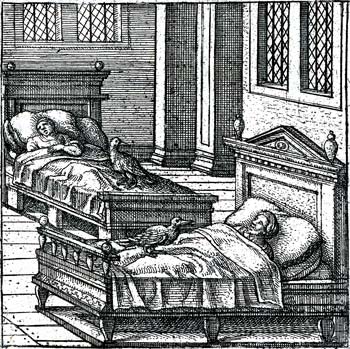The Physiologus says the caladrius (or charadrius) is an all-white bird with no trace of black at all. When placed on the bed of a sick person, the caladrius knows if he will live or die. If the person will die, the caladrius looks away from him, but if he will live the bird looks directly into his face and draws the sickness into itself. The usual interpretation is that the caladrius is a figure of Christ, who is without blemish, and who can take away the "sickness" of sin. The Epiphanius version is similar; it says that Christ is entirely bright with no worldly blackness, and he averts his gaze from the sinner but looks into the face of the righteous. Both versions go on to ask why, if the caladrius is an unclean bird (as stated in the book of Deuteronomy) it can be used to represent Christ; the response is that the serpent is also unclean, but the scripture says "as Moses lifted up the serpent in the wilderness, so must the Son of Man be lifted up" (John 3:14). This is usually followed by the explanation that a symbolic animal can represent both good and bad attributes; the Epiphanius version omits this.
The van der Borcht copperplate engraving below shows both predictions of the caladrius: the person in the lower bed will live, but the one in the upper bed will die. The expressions on the faces of the sick people also shows that one is recovering while the other is not.
The woodcut below (from the Rome, 1577 edition) is essentially the same; the person on the left will recover but the one on the right will die.


